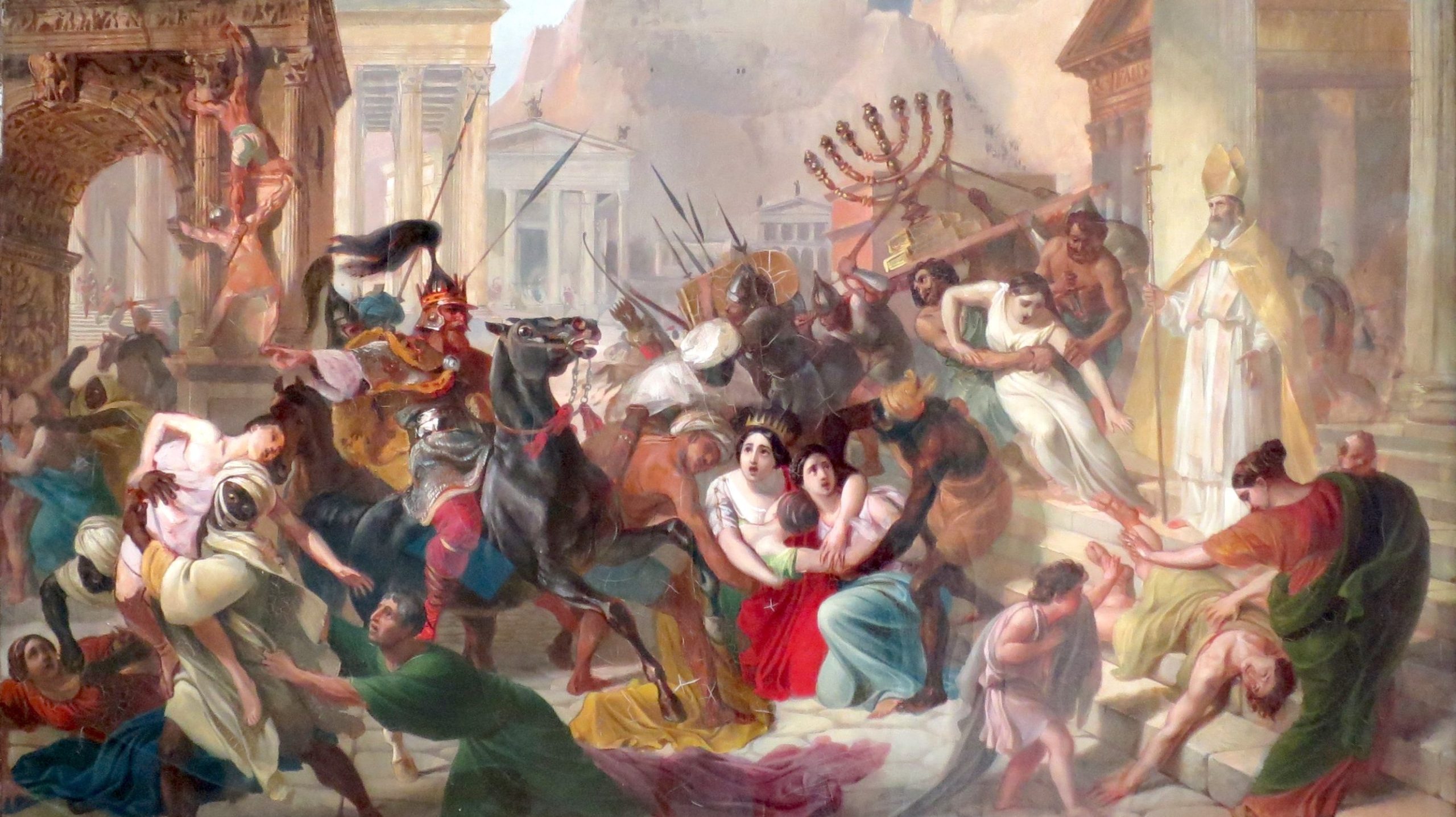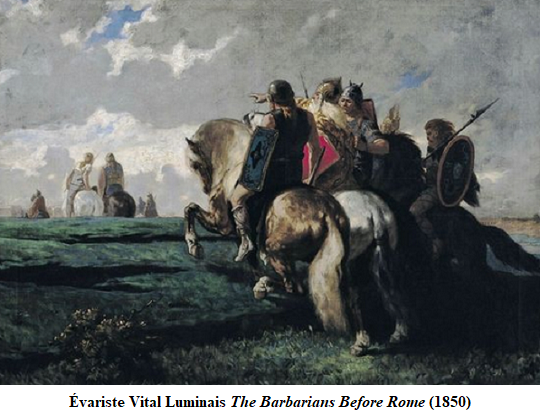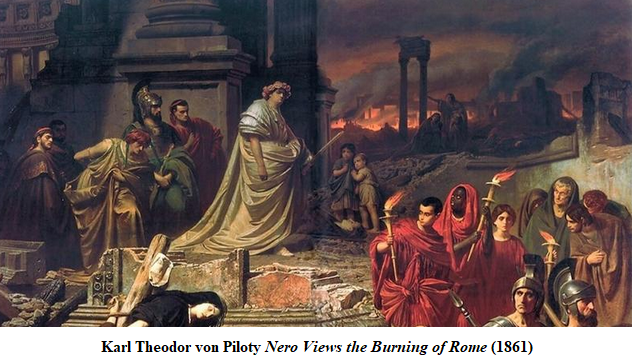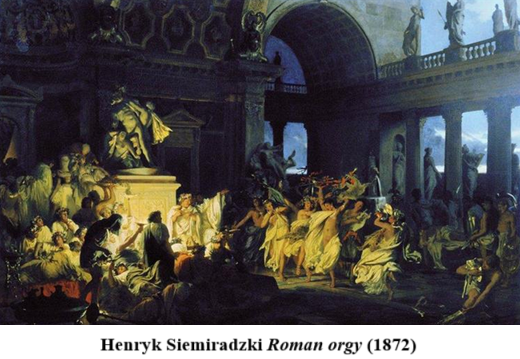Spectre of the Fall: is the West Doomed?
A spectre haunts Western Civilization – the spectre of its decline and fall. And invariably, it seems, this spectre is envisaged in terms of Rome, as Bryan Ward-Perkins confirms in The Fall of Rome & the End of Civilization (2006): “Deep within the Western psyche lies an anxiety that, if ancient Rome could fall, then so too can the even the proudest of modern civilizations”. Indeed, unfolding events “make it possible to use Roman history to show the West is experiencing only the beginnings of what will be an unfolding and, potentially, even an existential crisis, and secondly, that this crisis is revolving around the same key components that undermined its ancient Roman counterpart.” (Peter Heather & John Rapley, Why Empires Fall: Rome, America & the Future of the West, 2023)
Death Spiral The West may already have entered a ‘death spiral’ comparable to that which doomed the Roman Empire 1500 years ago, as Adam Creighton points out in a recent article, ‘Joe Biden’s decline is a perfect mirror of West’s slow decay’. He quotes prominent Stanford academic John Ionnidis, who defines such a precipitant societal collapse as a “vicious cycle of self-reinforcing dysfunctional behaviour characterised by continuous flawed decision making, myopic single-minded focus on one set of solutions, denial, distrust, micromanagement, dogmatic thinking and learned helplessness.”
Contrived Panics Climate change hysteria and the Covid-19 over-reaction may be cited as two example of this phenomenon. In particular,
Nothing confirms the collapse in governing wisdom so much as the destructive response to COVID-19, when across a few years almost all advanced governments crushed their citizens living standards, rights, and educational outcomes over a new virus whose fatality rate was known among experts from early 2020 to be less than 0.05%.
One result of this carefully contrived panic was that several gigantic pharmaceutical corporations made absolutely immense profits supplying vaccines that may have been either unnecessary or harmful, or both, but which were compulsory. Meanwhile they fund the regulators that were to meant to oversee their activities and ensure public health. It’s very notable that no comprehensive, properly empowered inquiry– e.g., a Royal Commission — into the Covid-19 disaster has been undertaken.
Stark Parallels The parallel with Rome is stark, as that civilization moved from its ascent phase into decline. The key here is elite behaviour: “In the earlier periods of the Roman Empire, the elites were willing to offer lives and treasure in the service of the common interest, while in the period of decline the elites became increasingly selfish.” In the first phase, the ratio of the income of the rich to that of the poor was about 20 times; in the latter period the ration had blown out many thousands of time, a situation “not far beyond what it is now in the US and Europe”, and increasingly in Australia. Here we find the mega-rich using their wealth to fund the ALP, the Teals, and other suitably pliant politicians to promote their private political obsessions, especially harebrained (but lucrative) ‘renewable energy’ schemes, despite the devastating impact such schemes are having on the living standards of the masses and will continue to have far into the future. Using Rome as a template, the ultimate outcome of such elite behaviour is readily predictable:
Societies fall apart and societal dysfunction rises when an ever increasing group of have nots are unable to sustain themselves … and the differences between the elite and the masses have become too big to bridge.
Uncontrolled Migration Another example of this ‘death spiral’ is the arrogant attitude of the elites to uncontrolled immigration, with its impact on housing, inflation and employment: “At the same time [as] voters demand cuts to immigration, governments have deliberately flooded their countries with millions of unwanted new immigrants, legal and illegal.” The parallel with the Fall of Rome is once again glaring, as it was the massive series of invasions of the barbarian peoples into the Empire, facilitated by corrupt and flaccid government, that signed its death warrant.
It was the massive series of invasions of the barbarian peoples into the Empire, facilitated by corrupt and flaccid government, that signed its death warrant.
Edward Gibbon This vision of history and the urgent warning it conveys has been a feature of Western culture right from the moment the West began its rise to global ascendency at the start of the Modern Era, on the back of science, capitalism, liberalism, imperialism, and the other key components of modernity that one prominent  historian has called the ‘killer apps’ that gave the West its head start. And this vision received its most iconic expression in Edward Gibbon’s magisterial multi-volume work, The History of the Decline and Fall of the Roman Empire, (1776-89). For Gibbon (left), his work addressed “the greatest, perhaps, and most awful scene in the history of mankind.” He was looking back across 1200 years to the final defeat and ruination of a monumental human achievement, a civilization that had grown and thrived for a millennium, before it succumbed to a multitude of mortal challenges, gave up its spirit, and passed out of history. Ever since then, speculation about the future of Western Civilization has been a dialogue with Gibbon and the vision he articulated so well – a dialogue in which Rome looms in spectral form as the symbol of what can be achieved through the monumental efforts of generations of people, but can also be frittered away, wasted, given up, and lost forever by later generations, afflicted by traitorous and incompetent elites.
historian has called the ‘killer apps’ that gave the West its head start. And this vision received its most iconic expression in Edward Gibbon’s magisterial multi-volume work, The History of the Decline and Fall of the Roman Empire, (1776-89). For Gibbon (left), his work addressed “the greatest, perhaps, and most awful scene in the history of mankind.” He was looking back across 1200 years to the final defeat and ruination of a monumental human achievement, a civilization that had grown and thrived for a millennium, before it succumbed to a multitude of mortal challenges, gave up its spirit, and passed out of history. Ever since then, speculation about the future of Western Civilization has been a dialogue with Gibbon and the vision he articulated so well – a dialogue in which Rome looms in spectral form as the symbol of what can be achieved through the monumental efforts of generations of people, but can also be frittered away, wasted, given up, and lost forever by later generations, afflicted by traitorous and incompetent elites.
The Life-Cycle of Civilizations Gibbon’s monumental work suggested that civilizations pass through a great life-cycle, comprising two essential movements: the first phase of ascent and flourishing; the second of decline and decrepitude.
Phase 1: Ascent This involves the notion that mighty empires can be constructed laboriously over centuries by an energetic and resourceful people. They develop irresistible military, economic, and spiritual power; expand their borders in a seemingly endless fashion; carry their message to the wider world; impose their own unique order upon it; and flourish for centuries, taking civilization many steps forward.
Deep Foundations To illustrate this ascending phase, Gibbon invokes the Greek historian Polybius, who had witnessed Rome’s annihilation of Carthage and whose work revealed “the deep foundations of the greatness of Rome.” Gibbon then enumerates some of these: Civic Commitment; a Strong and Balanced Constitution; a Citizen Army; the Roman Military System; the Primacy of Honour; the Imperial Drive; Rome’s Vast Expanse. Above all, Rome’s greatness was based on “the fidelity of the citizens to each other and to the state,” and their respect for the achievements of past generations.
Expansion He also emphasizes how Rome advanced “with rapid steps to the Euphrates, the Danube, the Rhine, and the Ocean”, driven onward by “the spirit and success of a people incapable of fear and impatient of repose”. During an era universally recognized as the Golden Age (A.D. 98-180), Rome had a population of some one million people, the first city ever to reach such a size, while the Empire as a whole embraced some 75 million people, a quarter of the entire population of the world.
Phase 2: Descent But eventually the second movement began: decline. Gibbon identified various reasons for the decline and fall, all of which may have great contemporary relevance for our present inquiry. They may be summarized as follows: an Over-Powerful Military; the East-West Division; Christian Passivity; Religious Sectarianism; the Size of the Threat; the Barbarian Migrations; the Disempowerment of its Citizens; the Decadence of the Royal Court; and the Decline of the Roman Martial Spirit.
Internal Weakness Following Gibbon, it seems that even great civilizational edifices like Rome will fail once they lose their élan, become enervated and morally exhausted. Faced with external challenges but burdened by internal weakness, they struggle and try to resist their enemies but are overwhelmed. Demoralized, their champions withdraw and only their vociferous critics remain, desperately eager to tear down the edifice, which they deeply resent – “the best lack all conviction; the worst are full of passionate intensity” as W. B. Yeats observed. Eventually, perhaps quite quickly, such a civilization begins to disintegrate and enters a process of decline and fall. In the end, all is lost, frittered away by generations that do not comprehend the colossal achievement on which they are turning their backs; willfully, they refuse to defend or even value it – they surrender to their enemies, perhaps hopeful of a comfortable subjugation. Such negative qualities are easily found throughout the political, academic, and cultural elites in the US, the UK, and Australia
Such negative qualities are easily found throughout the political, academic, and cultural elites in the US, the UK, and Australia
The Principle of Decay In his ‘General Observations on the Fall of the Roman Empire in the West’ describes how the sheer scale of Rome’s achievement bred complacency: the ease and comforts of the present were taken for granted, while the epic struggles and sacrifices of the past were willfully forgotten. Over time this complacency became corrosive of the entire civilizational structure: “prosperity ripened the principle of decay; the causes of destruction multiplied with the extent of conquest; and as soon as time or accident had removed the artificial supports, the stupendous fabric yielded to the pressure of its own weight,” began to crumble like the walls of a great city under siege, and then gave way. For many commentators, we are presently witnessing this process.
A Fatal Sequence There were other attempts to identify the ‘life-cycle’ of civilizations, almost always focusing on the causes and process of descent. It was felt they might be transient things, following a pre-destined cycle of growth, decay, and destruction. For example, the Victorian Historian J.M. Froude summarized the process as follows: “Virtue and truth produced strength, strength dominion, dominion riches, riches luxury, and luxury weakness and collapse – a fatal sequence repeated so often.”
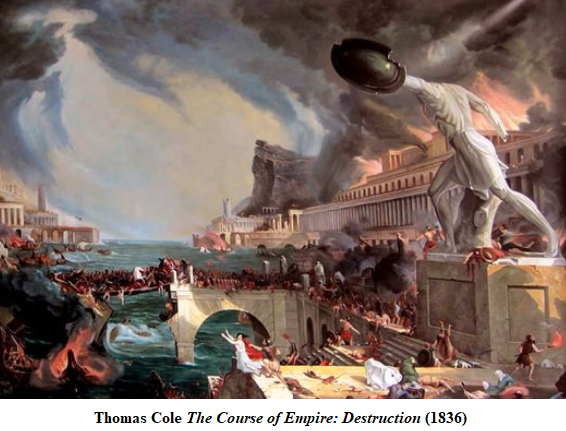 Racial Theories Some theories of civilizational decline were racial. For example, the famous Afro-American sociologist, W.E.B. Du Bois, used his theory of ‘black supremacy’ to predict the decline of the West. In Dark Princess (1928) and other works he claimed that it was persons of colour who possessed the essential ‘civilizational’ qualities of artistic and cultural creativity – ‘soul’ – and that “the darker peoples are the best – the natural aristocracy, the makers of art, religion, philosophy, life, everything!” Europeans owed their global dominance to capitalism and imperialism, and these would soon come crashing down, taking a degenerate Western Civilisation with them. After this, Du Bois believed Africa would rise to lead the world. This theme was taken up a generation later by the founder of post-colonial theory, Frantz Fanon, who advocated ‘exemplary violence’ against white colonizers as a means by which subjugated people of colour could reclaim their self-respect and dignity and carry out a revolution.
Racial Theories Some theories of civilizational decline were racial. For example, the famous Afro-American sociologist, W.E.B. Du Bois, used his theory of ‘black supremacy’ to predict the decline of the West. In Dark Princess (1928) and other works he claimed that it was persons of colour who possessed the essential ‘civilizational’ qualities of artistic and cultural creativity – ‘soul’ – and that “the darker peoples are the best – the natural aristocracy, the makers of art, religion, philosophy, life, everything!” Europeans owed their global dominance to capitalism and imperialism, and these would soon come crashing down, taking a degenerate Western Civilisation with them. After this, Du Bois believed Africa would rise to lead the world. This theme was taken up a generation later by the founder of post-colonial theory, Frantz Fanon, who advocated ‘exemplary violence’ against white colonizers as a means by which subjugated people of colour could reclaim their self-respect and dignity and carry out a revolution.
The Rising Tide A contemporary of Du Bois, Lothrop Stoddard, published The Rising Tide of Colour (1920) and The Revolt Against Civilization (1922). He predicted the internal decay of the West as an unemployable underclass grew in power, accompanied by the collapse of the European empires in the face of Third World nationalism, the industrialization of Japan, China, and India, the rise of Japan as a world power prepared to go war with America, along with a second war in Europe, a Third World population explosion, mass uncontrolled migration into the West, and the rise of Islam as a major threat to Western Civilization. Both Du Bois and Stoddard believed the defining factor in future global history would be ‘the colour line’ between the European races and people of colour.
The Law of Civilization and Decay A later ally of Gibbon was the American historian, Brooks Adams. In The Law of Civilization and Decay he propounded his theory of an historical cycle of expansion, concentration, and collapse that applied to both Rome and America (amongst others). In the final act, it is the treason of the elites that proves fatal: “As the Roman people sank into serfdom and destitution, the Senatorial class had to hire mercenary soldiers to defend their wealth and shore up an increasingly unstable frontier against Rome’s enemies. The Roman martial spirit declined, the mercenary hirelings became dictators, the frontier collapsed, and the barbaric hordes poured into the Empire.”
The Decline of the West Only one work rivals Gibbon’s in terms of influence This is The Decline of the West (1918/23), by the German philosophical historian, Oswald Spengler. Spengler believed that civilizations are actually organic forms that pass through a 1000-year life-cycle of birth, youth, maturity, decline, and ultimately death. Beginning as a creative, spontaneous, and energetic ‘Kultur’ civilizations slowly lose their élan and decline into a mechanical, bureaucratic, formalistic, and desiccated form of ‘Zivilization’. They then decline into old age, blindly thrashing about as they try desperately to survive in the face of challenges they are too decrepit to confront. Western Civilization had risen into maturity and global dominance over the previous two centuries, but the cataclysmic Great War signaled its end; new powers emerged to fight for dominance and are still appearing a century after Spengler’s tome came out.
Some Contemporary Theories There are currently many authors exploring the theme of the rise and decline of Western Civilizations (See appendix). Possibly the leading figure is the prominent economic historian, Sir Niall Ferguson. In Civilization: The West and the Rest, (2011; accompanied by a six-part TV documentary, Civilization: Is the West History?), he asked: “Why, beginning around 1500, did a few small polities on the western end of the Eurasian landmass come to dominate the rest of the world?” Ferguson pointed out that in 1500 the dominant nations in Europe controlled 10% of the globe and generated some 40% of its wealth, while by 1913 the West controlled almost 60% of the globe and generated almost 80% of its wealth.
By 1913 the West controlled almost 60% of the globe and generated almost 80% of its wealth.
‘Killer Apps’ Ferguson explains this centuries-long rise to global supremacy in terms of the West’s use of six ‘killer apps’ (i.e., revolutionary cultural and technical resources), largely missing elsewhere in the world, e.g., science and the scientific method, competition (including freedom of thought and expression), the rule of law (including respect for private property), and the (Protestant) work ethic, together supporting the emergence of Liberal Democratic Capitalism. But now, a century later, Ferguson believes the West had lost its edge and that the future belongs to China and other Asian nations, which have appropriated the most important of these ‘killer apps’. Consequently, we are witnessing the ongoing decline of the West, while an authoritarian, technocratic state capitalist regime like China is a hegemonic global power.
The End of History? What happened after 1913 to bring this about? With the onset of the catastrophic Great War, largely driven by Imperialist rivalries, Europe sucked the rest of the world into a period of military, political and cultural conflict on an unprecedented scale, as several powerful totalitarian regimes challenged the West for global supremacy. Nazi Germany, and Fascist Italy and Japan were defeated in WWII, leaving the West locked in a Cold War (1945-91) with the Communist bloc led by the Soviet Union, a struggle that threatened at times to explode into a nuclear apocalypse. But then, around 1990, the Soviet Union and much of the Communist bloc collapsed and it seemed suddenly that Liberal Democracy had triumphed, and that we had reached ‘the End of History’, as celebrated in an extremely influential book, The End of History and the Last Man (1992) by the American political scientist, Francis Fukuyama. According to Fukuyama, just a generation ago, humanity had reached “not just … the passing of a particular period of post-war history, but the end of history as such: That is, the end-point of mankind’s ideological evolution and the universalization of Western liberal democracy as the final form of human government.”
9/11 This happy conclusion proved premature as, just a decade later, the terrorist attacks of September 11 2001 announced the emergence of another great global antagonist, Radical Islamism, which had its own ideas about which way history was heading and which civilization would prevail, a direction determined not by economics but by religion – a conviction sanctioned by a fundamentalist reading of the Holy Koran, and supported by hordes of fanatical supporters, represented by the Muslim Brotherhood, al Qaeda, ISIS, Hamas, Hezbollah, Hizb ut-Tahrir, etc., backed up by many billions of petrodollars and political and military support provided by Shia Iran, and many Sunni Muslim states, and by their very influential supporters in the West, including their high-profile and politically protected ‘useful idiots’ in Australia.
A Clash of Civilizations? This ongoing conflict for global hegemony had been predicted in The Clash of Civilizations and the Remaking of World Order (1996) by the American political scientist Samuel P. Huntington. He argued that the primary source of conflict in the post–Cold War period would be a struggle to assert cultural and religious identities founded in long-established civilizations, of which he identified nine (see map). He rejected Fukuyama’s optimism, insisting that belief in the universality of Western values (e.g., liberal democracy, human rights, a free market economy, separation of church & state, etc.) is naïve and that attempts to impose them will only antagonize other civilizations and generate a cultural, religious and political backlash. He also detected a major shift of economic, military, and political power away from the West and the emergence of powerful ‘challenger civilizations’, i.e., the Chinese and the Islamic, to which may now be added Putin’s Kleptocracy posing as Russian Orthodox. Huntington predicted that major future conflict would break out along ‘fault lines’ between competing civilizations, e.g., in Ukraine, Israel, Taiwan, etc.
Contemporary Shocks At the start of the new millennium, the 9/11 and subsequent terrorist attacks (including in Bali) inspired by Radical Islamism were incredibly traumatic events that fundamentally re-shaped perceptions of global order and future history. They were then followed by the Global Financial Crisis of 2007-8, the most severe worldwide economic disaster since the Great Depression, and suddenly the mighty pillars of global capitalism seemed to be on the verge of collapse. Meanwhile, Communist China, pursuing a dynamic form of state capitalism, grew its economy almost exponentially from 2% of global GDP in 1980 to 18% in 2021, becoming the manufacturing powerhouse of the world, with military capabilities rivalling those of the United States, the principal guarantor of the liberal global order. In the background there has been the relentless threat of a vastly hyped climate catastrophe, accompanied by the Covid pandemic (2020-23), which caused some 800 million cases and seven million deaths across the planet (and delivered absolutely massive profits to large pharmaceutical companies). Since then there has been the Russian invasion of Ukraine (launched in February 2022) and the Israel-Hamas war in Gaza (launched in October 2023), both of which have revived the horror of large-scale military conflict involving advanced societies and civilian populations, while threatening to break-out into broader general warfare, perhaps (some fear) even WWIII!
The Gaza War also confirmed that there are fundamental divisions in the internal political culture of Western nations, as various movements orientate themselves around sectarian identities.
Internal Division The Gaza War also confirmed that there are fundamental divisions in the internal political culture of Western nations, as various movements orientate themselves around sectarian identities (e.g., race, gender, religion, etc.) rather than liberal democratic values, a shift confirmed by various poll results showing a significance decline in belief in liberal democratic values and increasing support for authoritarianism. This shift is especially obvious among young people, where surveys show that less than half feel it is ‘essential’ to live in a democratic society.
Grim Speculation Unsurprisingly, and despite the extreme optimism of ‘the End of History’ school of thought so prevalent only a generation ago, there has been a flood of grim speculation since 9/11 about the future of the West and of the civilization of modernity that it had nurtured and upon which it had thrived for a quarter of a millennium. As the prominent critic of Islamism and champion of Muslim women’s rights, Ayaan Hirsi Ali, observed in November 2023, the West is under threat from “the resurgence of great-power authoritarianism and expansionism in the forms of the Chinese Communist Party and Vladimir Putin’s Russia; the rise of global Islamism, which threatens to mobilize a vast population against the West; and the viral spread of woke ideology, which is eating into the moral fibre of the next generation.” The extent to which the Left has been able (paradoxically) to mobilize the young around support for both arch-reactionary radical Islam and hyper-progressivist woke ideology is a measure of the extent of the internal decay from which Western societies are suffering.
The West Must Die These ‘declinists’ are fortified in their embrace of Western decline by many contemporary commentators for whom, the West is “of all civilizations, uniquely rapacious, racist, sexist, exploitative, environmentally destructive, and hostile to all human dignity. It is unredeemable. Only if the West goes down to destruction can the rest of the human race hope to survive.” (David Gress, From Plato to NATO, 1998).
Degeneration Niall Ferguson attributes this internal decay in the West to institutional failure. In The Great Degeneration: How Institutions Decay and Economies Die (2013) he focuses on the phenomenon of slowing economic growth, increasingly burdensome household and government debt, increasing inequality, inflation, housing shortages, ageing populations, antisocial behaviour, breakdowns in the justice system, etc., and explains these in terms of the decadence of the West’s central institutions and its inability to address the challenges it faces.
Eurabia An example of such failures is the emergence of a post-Christian ‘Eurabia’, the name given to an increasingly Islamized Europe, exemplified by France, as we see presently in Paris during the Olympics, as heavily armed security forces outnumber the athletes. The future shape of Eurabia is evoked powerfully in the best-seller, Submission (2015) by Michel Houellebecq, in which a Muslim political party upholding strict Islamist values wins the presidency with the support of the Socialist Party. The concept was developed by the Egyptian-born, British-French-Jewish author, Bat Ye’or, in her book, Eurabia: The Euro‐Arab Axis (2005), according to which the European ruling elites, led by the European Union, the universities, innumerable think tanks, the mainstream media, and much of social media, have largely abandoned the core principles of Western Civilization. She believes they are progressively surrendering to Islam and adopting a submissive status towards it (i.e., ‘dhimmitude’), which leads them to excuse Islamist terrorism and mass illegal immigration, while providing enormous economic subsidies to corrupt Muslim regimes and Radical Islamist movements, e.g., Hamas, etc. (Interestingly, there now appears to be a major populist reaction in Europe to the adoption of this submissive status by the elites.)
Comparison With Rome Ferguson also has issues with the EU, and sees it as promoting forces similar to those that undermined the Western Roman Empire: “Uncannily similar processes are destroying the European Union today … Like the Roman Empire in the early 5th Century, Europe has allowed its defences to crumble. As its wealth has grown, so its military prowess has shrunk, along with its self-belief. It has grown decadent … At the same time, it has opened its gates to outsiders who have coveted its wealth without renouncing their [own] ancestral faith.”
The Great Völkerwanderung Ferguson compares the recent mass influx of illegal immigrants into Europe and other Western countries to the ‘Wandering of the Peoples’ (Völkerwanderung) that took place some 1500 years ago. This occurred when the Huns erupted out of Asia into Europe, driving millions of Goths and other Germani peoples across the borders and into the Roman Empire, overwhelming it and precipitating its decline and eventual fall. He laments that France has apparently become a lost cause, a declining state faced with an Islamic onslaught that will sweep aside everything opposing it, all with the connivance of the EU, which was then trying to take Britain down with it until Brexit occurred.
If this path of self-destruction is the one that Europe is taking, then the role played by America in the preservation of Western Civilization becomes even more central
“An Empire in Denial” If this path of self-destruction is the one that Europe is taking, then the role played by America in the preservation of Western Civilization becomes even more central, especially as the reality of global politics requires superpower leadership, and only the US can fill this role. However, in Colossus (2004) Ferguson laments that, at the level of national leadership, America is an “empire in denial”, and that this reflects a deep-seated uncertainty and failure of nerve within the American ruling elite, even after the 9/11 attacks. He concludes that “the threat to America’s empire does not come from … rival empires to the West or the East. I regret to say that it may come from the vacuum of power – the absence of a will to power – within”. He argues Europe and other Western nations have lost the will to live and America may have done the same. It appears it is in this context that the ongoing Trump phenomenon may be assessed.
Elites vs Counter-Elites An interesting perspective on these declinist developments is offered in End Times: Elites, Counter-Elites & the Path of Political Disintegration (2023), a book by Peter Turchin, the co-founder of cliodynamics (the application of very large-scale mathematical modelling to long-term historical processes). In a 2010 article in Nature, Turchin used this modelling technique to predict that America had entered into a spiral of social disintegration that would lead to a breakdown in the political order within a decade, c.2020, a prediction many believe has been realized with the rise of the Trump political insurgency and the January 6, 2021, riots.
The Circulation of Elites Turchin uses a ‘circulation of elites’ model of regime change developed by the Italian sociologist Vilfredo Pareto (1848–1923), and he claims that the lessons of global history are clear: particular elites rule over the usually submissive masses; however, when the balance tips too far in favour of the elites, especially in terms of the distribution of wealth, status and power, then political instability becomes inevitable, as ‘counter-elites’ emerge. This process is motivated by the ‘overproduction’ of elite candidates and by the increasing activism of these elite aspirants, i.e., those who seek to escape poverty, status insecurity, and powerlessness, by gaining entry into elite positions, and who feel they have a legitimate right to do so. As elite positions are limited, frustrated aspirants turn to the masses and seek to mobilize them to overturn the established order. Once again, the Trump insurgency may fit this model.
Populism This process – often labelled ‘populism’ (e.g., Roger Eatwell & Matthew Goodwin, National Populism: The Revolt Against Liberal Democracy, 2018) – gives rise to a propaganda war as the elites and counter-elites compete for the allegiance of the masses and seek to mobilize their support. Turchin believes that when this situation has been reached, societies become locked in a death spiral from which it’s very difficult to exit. In the case of the U.S. he believes this process has been underway for two generations, is presently exemplified by the rise of Donald Trump and his MAGA movement, and the liberal elite resistance to it, and that a violent political upheaval seems inevitable Similar insurrectionary (‘populist’) processes appear to be underway in France, the Netherlands, and elsewhere in Europe.
Is Demography Destiny? A quite different perspective on the fall of civilizations bypasses the politics and focusses instead on the profound effects of drastic demographic decline. Such decline is a feature of modernity and has confronted the West for some time but may now be reaching a crisis point. As Mark Steyn observes in America Alone: The End of the World as We Know It (2006), Europe faces the legendary ‘Four Horsemen of the Apocalypse’:
“Death – the demise of European races too self-absorbed to breed; Famine – the end of the lavishly-funded statist good times; War – the decline into bloody civil unrest that these economic and demographic factors will bring; and Conquest – the re-colonization of Europe by Islam”.
Such decline is a feature of modernity and has confronted the West for some time but may now be reaching a crisis point.
Waves of Disaster However, this ‘recolonization’ may be a race against time for the Muslim world, as it also seeks to escape a similar demographic calamity, but one delayed by several decades. As David Goldman explains in How Civilizations Die (And Why Islam is Dying Too) (2011), the disaster will first engulf Europe and other developed economies but then, after a period of some decades, it will also devastate the Muslim world. The key difference will be that Europe possesses considerable economic, cultural, and institutional resources to draw upon to alleviate the impact; Islam, on the other hand, will not be so fortunate, and when the blow comes, in the latter half of this century, it will decimate what remains of that civilization. Indeed, Islam confronts a catastrophe in its homelands that may easily dwarf that facing Europe and other Western societies. This was recognized by the past president of Iran, Mahmoud Ahmadinejad, who condemned the plummeting fertility rates in his Muslim theocracy: “Negative population growth will cause the extinction of our identity and culture”, he complained, declaring it a self-inflicted “act of genocide” by the young women of Iran and of elsewhere in the Muslim world.
Cultural Despair This demographic calamity, Goldman argues, betrays a terminal malady, a debilitating cultural despair – a nihilism – that is rapidly corroding the finely knit cultural and social fabric that sustains all civilizations. The implications of this are profound. As Goldman observes about the decline of civilizations in general:
“the death of a culture is an uncanny event, for it erases not only the future but also the past, that is, the hopes and fears, the sweat and sacrifice of countless generations whose lives no longer can be remembered”, but whose efforts and sacrifices built the civilization that is now being lost.
Bleak Futures The nature and scale of the global demographic future are becoming ominously clear. As Goldman points out, on present trends, “in the second half of this century most of the great powers of the past – Germany, Spain, Italy, Russia, and Japan, among others – will cease to function. A century later they will have ceased to exist”. In Western Europe, by 2100 the working-age population will have fallen by about 40 percent and by some 66 percent in Eastern Europe, Russia, and East Asia. The least fertile European nations face a population decline of 40-60 percent, with Germany’s population projected to decline by 98 percent over the next 200 years if present trends continue, i.e., it will cease to exist in any recognizable form.
Tipping Point Goldman believes that there is a civilizational tipping point, a moment when the spiritual and cultural resources of a people or a nation are exhausted or destroyed and it is no longer possible for them to attain or retain a sense of immortality through participation in a great chain of generations stretching from the past into the future. At this point some nations “fight to the death. Others cease to breed. Some do both”. Global politics over the current century will be determined largely by which countries choose which of these paths.
Conclusion As this brief survey indicates, there is a considerable body of scholarship and commentary illuminating the dire future into which Western societies are allowing themselves to descend. Tragically, there seems to be little political will or capacity to confront this challenge, in itself a marker of the extent of the decline, but at the same time there are several political events approaching that may give rise to hope. Time will tell, but time is running out.
Appendix: The Fall of the West Recent works discussing the decline of the West include: Niall Ferguson, The War of the World and the Descent of the West (2006), Civilization: Is the West History? (2011), & Doom: The Politics of Catastrophe (2021); Bruce Thornton, Decline and Fall: Europe’s Slow-Motion Suicide (2007); Chalmers Johnson, Nemesis: The Last Days of the American Republic (2007); Naomi Wolf, The End of America (2007); Cullen Murphy, Are We Rome? The Fall of an Empire and the Fate of America (2008); Bruce Bawer, While Europe Slept (2007); Anthony Pagden, Worlds at War: the 2500 year Struggle between East and West (2008); Jared Diamond, Collapse: How Societies Choose to Fail or Succeed (2011); Walter Laqueur, After the Fall: The End of the European Dream and the Decline of a Continent (2012); Daron Acemoglu & James A. Robinson, Why Nations Fail (2013); Eric Zemmour, The French Suicide (2104); William Drozdiak, Fractured Continent: Europe’s Crises and the Fate of the West (2017); Douglas Murray, The Strange Death of Europe: Immigration, Identity, Islam (2017), & The War on the West (2022); James Kirchick, The End of Europe: Dictators, Demagogues, and the Coming Dark Age (2017); Samuel Gregg, Reason, Faith, and the Struggle for Western Civilization (2019); Paul Strathern, Rise & Fall: A History of the World in Ten Empires (2019); Peter Zeihan, The End of the World Is Just the Beginning: Mapping the Collapse of Globalization (2022); Peter Turchin, End Times: Elites, Counter-Elites & the Path of Political Disintegration (2023); and Peter Heather & John Rapley, Why Empires Fall: Rome, America & the Future of the West (2023).
